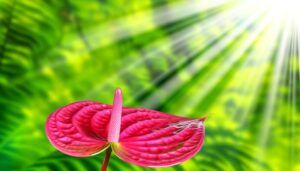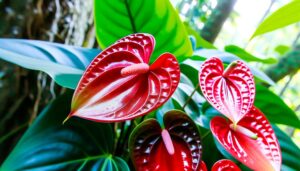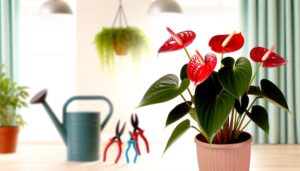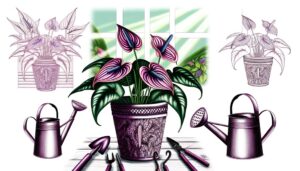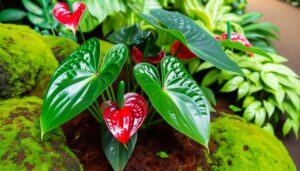Troubleshooting Common Red Anthurium Plant Problems
To troubleshoot common Red Anthurium plant problems, focus on several factors. Yellowing leaves typically result from nutrient deficiencies like iron, magnesium, and nitrogen, improper watering practices, or inadequate light.
Lack of flowers is often due to insufficient light, nutrient imbalances, and non-optimal temperature and humidity. Brown leaf tips indicate salt accumulation from over-fertilization, low humidity, or inconsistent watering.
Pests like aphids and mealybugs and diseases such as Anthracnose cause chlorosis, stunted growth, and necrotic lesions. Watering issues, including overwatering and underwatering, lead to root rot and wilting.
Effective management involves a combination of environmental control and balanced care protocols. Learn how to optimize these factors for a robust plant.
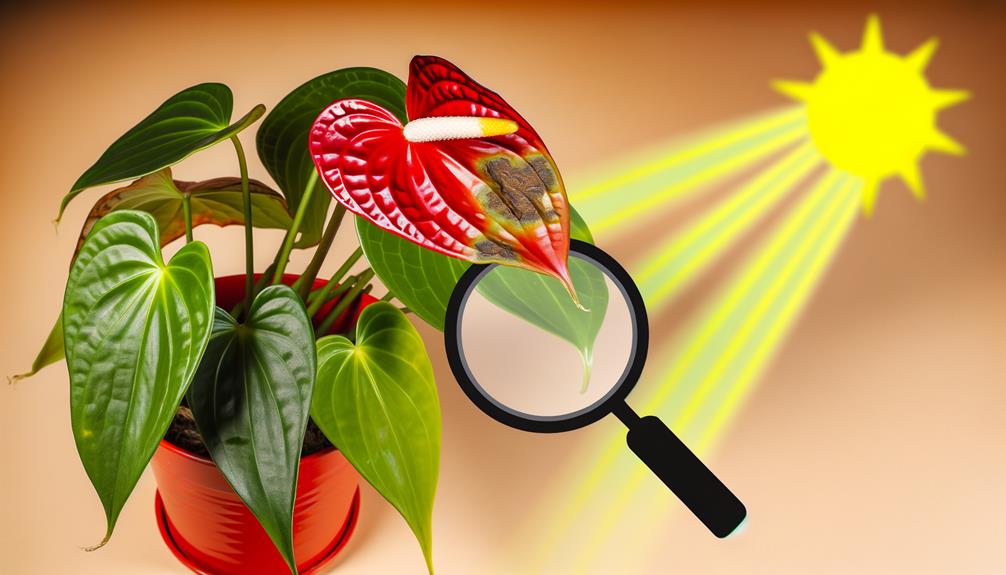
Key Takeaways
- Ensure balanced fertilization to prevent nutrient deficiencies causing yellowing leaves.
- Maintain consistent soil moisture to avoid root rot and leaf yellowing from improper watering.
- Provide adequate indirect light to support healthy leaf color and flower production.
- Monitor and control humidity levels above 60% to prevent brown leaf tips and promote blooming.
- Regularly inspect for pests like aphids and mealybugs, and use biological controls for effective management.
Yellowing Leaves
Yellowing leaves in red anthurium plants are often indicative of chlorosis, which is typically caused by nutrient deficiencies, improper watering practices, or inadequate light conditions. Chlorosis manifests as a reduction in chlorophyll concentration, impairing photosynthesis and resulting in pale or yellow foliage.
Key nutrient deficiencies include iron, magnesium, and nitrogen, essential for chlorophyll synthesis and plant vitality. Overwatering can precipitate root rot, restricting nutrient uptake, while underwatering leads to desiccation and decreased metabolic function. Insufficient light impedes chloroplast function, exacerbating chlorosis.
Best care involves balanced fertilization, ensuring a steady supply of macro- and micronutrients, adherence to a controlled irrigation regimen, and provision of adequate, indirect light. Thorough diagnostic measures are crucial to accurately identify and ameliorate the underlying causes.
Lack of Flowers
A lack of flowers in red anthurium plants is frequently attributed to suboptimal environmental conditions. Common factors include inadequate light levels, improper fertilization, or unsuitable temperature and humidity ranges.
Making sure anthuriums receive bright, indirect light is essential, as insufficient light can hinder blooming. Nutrient imbalances, particularly deficiencies in phosphorus, may result in poor flower development; therefore, a balanced, slow-release fertilizer is recommended.
Additionally, temperature should be maintained between 65-80°F (18-27°C) to promote flowering, while humidity levels should remain consistently high, ideally above 60%.
- Light Levels: Provide bright, indirect light.
- Fertilization: Use balanced, slow-release fertilizer.
- Temperature: Maintain 65-80°F (18-27°C).
- Humidity: Keep levels above 60%.
Addressing these factors can greatly improve flower production in red anthurium plants.
Brown Leaf Tips
Another common issue faced by red anthurium plants is the development of brown leaf tips, which can be indicative of several underlying physiological or environmental stress factors. Excessive salt accumulation from over-fertilization can lead to osmotic stress, causing desiccation at the leaf margins.
Inadequate humidity levels, often below 60%, can also result in tip necrosis due to inadequate transpiration. Additionally, inconsistent watering practices, such as allowing the substrate to completely dry out, may exacerbate this condition by leading to uneven water uptake.
Poor quality irrigation water containing high levels of fluoride or chlorine can further contribute to cellular damage at the leaf tips. Ensuring ideal environmental conditions and proper cultural practices is crucial in mitigating this common foliar symptom.
Pests and Diseases
Pests and diseases can greatly impact the health and aesthetics of red anthurium plants. Common culprits include aphids, mealybugs, and fungal pathogens such as Anthracnose. Aphids and mealybugs feed on plant sap, causing chlorosis and stunted growth. Anthracnose results in necrotic lesions on leaves and stems. Effective management involves regular inspection and early intervention.
Aphids are small, soft-bodied insects that cluster on new growth, causing leaf curl and honeydew secretion.
Mealybugs appear as cotton-like masses on stems and leaves, leading to wilting and sooty mold.
Anthracnose is a fungal disease that produces dark, sunken lesions, often exacerbated by high humidity.
Biological Controls involve the introduction of beneficial insects like ladybugs and lacewings to mitigate pest infestations naturally.
Regular monitoring and appropriate treatment are essential for maintaining plant health.
Watering Issues
Improper watering practices are a common issue that can lead to a variety of physiological disorders in red anthurium plants, including root rot and leaf yellowing. Overwatering creates a vital environment, fostering anaerobic conditions that promote pathogenic fungi, such as Phytophthora and Pythium, leading to root necrosis.
Conversely, underwatering results in cellular dehydration and impaired turgor pressure, causing chlorosis and wilting. Best irrigation involves maintaining consistent soil moisture without waterlogging, achieved by using a well-draining substrate.
Monitoring soil moisture levels with a hygrometer can offer precise data for timely interventions. Employing a balanced watering regimen tailored to the plant's developmental stage and environmental conditions is essential for maintaining the physiological integrity and aesthetic appeal of red anthuriums.
Conclusion
To wrap up, the red anthurium plant, frequently celebrated as the epitome of indoor gardening, appears to hold its own scheme of biological sabotage. From the discoloration of leaves to the stubborn resistance to blossom, it offers a wide array of gardening obstacles.
The brown leaf edges and vulnerability to pests and illnesses additionally highlight its mysterious character. Clearly, becoming skilled at caring for this botanical puzzle demands not only gardening skills but also unwavering determination and maybe a hint of humor.

